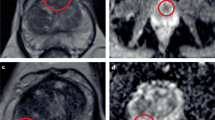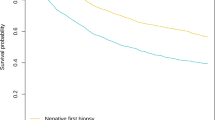Abstract
Active surveillance for favorable-risk prostate cancer has become increasingly common in populations in which screening for prostate cancer is widespread, owing to evidence that in many patients screening results in the detection of disease that is not clinically significant (i.e. untreated, it would not pose a threat to health). The approach is supported by data demonstrating that patients who have clinically insignificant disease can be identified with reasonable accuracy, and that patients who are initially classified as low risk but reclassified over time as higher risk and are treated radically are still cured in most cases. It is important to identify patients who have a low probability of disease progression during their lifetime according to clinical and pathologic features of the disease, patient age and comorbidity. Close monitoring of patients over time and availability of reasonable criteria for intervention, which will both identify more-aggressive disease in a timely fashion and not result in excessive treatment, are crucial. It is also important to communicate appropriately with the patient, to reduce the psychological burden of living with untreated cancer. The results of active surveillance, the criteria for patient selection and the appropriate thresholds for intervention are reviewed in this article.
Key Points
-
Patients with favorable-risk prostate cancer are at low risk of death from cancer
-
Current practice often results in overtreatment
-
Favorable-risk patients can be identified on the basis of the cancer grade, prostate-specific-antigen level, tumor stage and biopsy-volume of cancer
-
A policy of active surveillance with selective, delayed intervention seems to be safe
-
Intervention is warranted for a prostate-specific-antigen doubling time of <3 years or grade progression on repeat biopsy
-
Managing these patients presents a major communication challenge for the health-care team
This is a preview of subscription content, access via your institution
Access options
Subscribe to this journal
Receive 12 print issues and online access
$209.00 per year
only $17.42 per issue
Buy this article
- Purchase on Springer Link
- Instant access to full article PDF
Prices may be subject to local taxes which are calculated during checkout
Similar content being viewed by others
References
Nadler RB et al. (2005) Use of 2.6 ng/ml prostate specific antigen prompt for biopsy in men older than 60 years. J Urol 174: 2154–2157
Welch HG et al. (2005) Prostate-specific antigen levels in the United States: implications of various definitions for abnormal. J Natl Cancer Inst 97: 1132–1137
Jemal A et al. (2007) Cancer Statistics, 2007. CA Cancer J Clin 57: 43–66
D'Amico AV et al. (1998) Biochemical outcome after radical prostatectomy, external beam radiation therapy, or interstitial radiation therapy for clinically localized prostate cancer. J Insur Med 30: 204–205
Sakr WA et al. (1993) The frequency of carcinoma and intraepithelial neoplasia of the prostate in young male patients. J Urol 150: 379
Albertsen P et al. (2005) 20-Year outcomes following conservative management of clinically localized prostate cancer. JAMA 293: 2095–2101
Albertsen PC et al. (2005) Prostate cancer and the Will Rogers phenomenon. J Natl Cancer Inst 97: 1248–1253
Stamey TA et al. (1993) Localized prostate cancer: relationship of tumor volume to clinical significance for treatment of prostate cancer. Cancer 71 (Suppl): S933–S938
Epstein JI et al. (1994) Pathologic and clinical findings to predict tumor extent of nonpalpable (stage T1c) prostate cancer. JAMA 271: 368–374
Epstein JI et al. (1993) Correlation of pathologic findings with progression after radical retropubic prostatectomy. Cancer 71: 3582–3593
Irwin MB and Trapasso JG (1994) Identification of insignificant prostate cancers: analysis of preoperative parameters. Urology 44: 862–867
Cupp MR et al. (1995) The volume of prostate cancer in the biopsy specimen cannot reliably predict the quantity of cancer in the radical prostatectomy specimen on an individual basis. J Urol 153: 1543–1548
Goto Y et al. (1996) Distinguishing clinically important from unimportant prostate cancers before treatment: value of systematic biopsies. J Urol 156: 1059–1063
Epstein JI et al. (1993) Is tumor volume an independent predictor of progression following radical prostatectomy? A multivariate analysis of 185 clinical stage B adenocarcinomas of the prostate with 5 years of followup. J Urol 149: 1478–1481
Epstein JI et al. (1998) Nonpalpable stage T1c prostate cancer: prediction of insignificant disease using free/total prostate specific antigen levels and needle biopsy findings. J Urol 160: 2407–2411
Noguchi M et al. (2001) Relationship between systematic biopsies and histological features of 222 radical prostatectomy specimens: lack of prediction of tumor significance for men with nonpalpable prostate cancer. J Urol 166: 104–109
Augustin H et al. (2003) Insignificant prostate cancer in radical prostatectomy specimen: time trends and preoperative prediction. Eur Urol 43: 455–460
Anast JW et al. (2004) Relating biopsy and clinical variables to radical prostatectomy findings: can insignificant and advanced prostate cancer be predicted in a screening population? Urology 64: 544–550
Graif T et al. (2007) Under diagnosis and over diagnosis of prostate cancer. J Urol 178: 88–92
Thompson IM et al. (2003) The influence of finasteride on the development of prostate cancer. N Engl J Med 349: 215–224
Choo R et al. (2001) PSA doubling time of prostate carcinoma managed with watchful observation alone. Int J Radiat Oncol Biol Phys 50: 615–620
Roemeling S et al. (2007) Active surveillance for prostate cancers detected in three subsequent rounds of a screening trial: characteristics, PSA doubling times, and outcome. Eur Urol 51: 1244–1250
Kakehi Y (2003) PSA DT in Japanese active surveillance cohort (48 patients). Jpn J Clin Oncol 33: 1–5
Teahan SJ and Klotz LH (2006) Current role of prostate-specific antigen kinetics in managing patients with prostate cancer. BJU Int 97: 451–455
Egawa S et al. (2000) Use of pretreatment prostate-specific antigen doubling time to predict outcome after radical prostatectomy. Prostate Cancer Prostatic Dis 3: 269–274
McLaren DB et al. (1998) Watchful waiting or watchful progression? Prostate specific antigen doubling times and clinical behavior in patients with early untreated prostate carcinoma. Cancer 82: 342–348
D'Amico AV et al. (2004) Preoperative PSA velocity and the risk of death from prostate cancer after radical prostatectomy. N Engl J Med 351: 125–135
Choo R et al. (2002) Feasibility study: watchful waiting for localized low to intermediate grade prostate carcinoma with selective delayed intervention based on prostate specific antigen, histological and/or clinical progression. J Urol 167: 1664–1669
Klotz L (2005) Active surveillance for prostate cancer: for whom? J Clin Oncol 23: 8165–8169
Bill-Axelson A et al. (2005) Radical prostatectomy versus watchful waiting in early prostate cancer. N Engl J Med 352: 1977–1984
Khan MA et al. (2003) Expectant management of localized prostate cancer. Urology 62: 793–799
Steineck G et al. (2002) Quality of life after radical prostatectomy or watchful waiting. N Engl J Med 347: 790–796
Acknowledgements
Désirée Lie, University of California, Irvine, CA, is the author of and is solely responsible for the content of the learning objectives, questions and answers of the Medscape-accredited continuing medical education activity associated with this article.
Author information
Authors and Affiliations
Ethics declarations
Competing interests
The author declares no competing financial interests.
Rights and permissions
About this article
Cite this article
Klotz, L. Active surveillance for favorable-risk prostate cancer: who, how and why?. Nat Rev Clin Oncol 4, 692–698 (2007). https://doi.org/10.1038/ncponc0966
Received:
Accepted:
Issue Date:
DOI: https://doi.org/10.1038/ncponc0966
This article is cited by
-
Active surveillance for low-risk prostate cancer: an update
Nature Reviews Urology (2011)
-
Immunhistochemische Algorithmen in der Prostatadiagnostik
Der Pathologe (2009)
-
Aktive Überwachung des Prostatakarzinoms
Der Urologe (2008)



